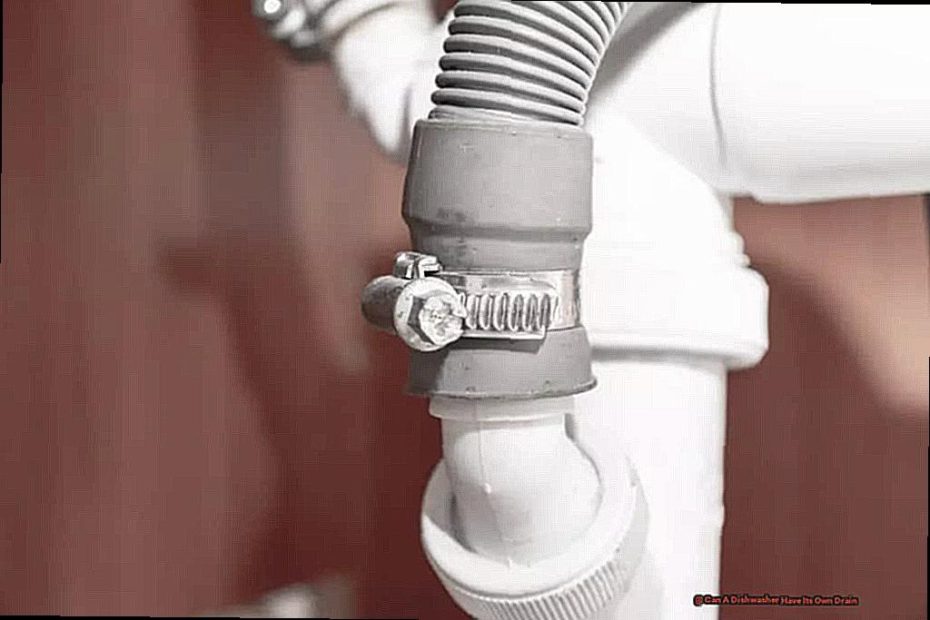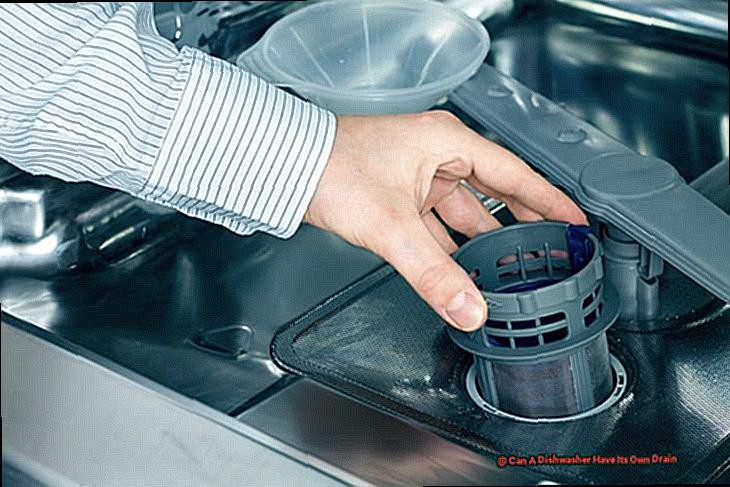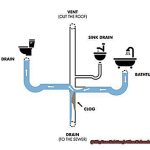Are you tired of constantly battling clogged drains and unpleasant odors in your kitchen? Are you searching for a solution to make dishwashing a breeze? Well, what if we told you that the answer may lie in your dishwasher having its own drain?
- Say farewell to pesky clogs and foul smells in your kitchen
- Imagine the convenience of a separate drain for your dishwasher
- No more fretting over food scraps and residue stuck in your sink’s drain
- Keep your kitchen smelling fresh and clean all day long
- This groundbreaking feature has the potential to revolutionize dishwashing as we know it
- But is it truly feasible for a dishwasher to have its own drain?
- Let’s delve into the possible advantages and drawbacks of this concept
- Could this be the future of dishwashing or just an outlandish idea?
- Get ready to immerse yourself in the world of dishwashers with their own drains.
Contents
- 1 Does Dishwasher Drain Only When On?
- 2 How Often Does the Dishwasher Drain?
- 3 How To Connect the Dishwasher Directly to the Drain?
- 4 What Are the Dishwasher Drain Options?
- 5 How Do You Install a Dishwasher Drain Without a Sink?
- 6 How to Install a Dishwasher Drain Without a Garbage Disposal?
- 7 Can a Dishwasher be Plumbed Anywhere?
- 8 Conclusion
Does Dishwasher Drain Only When On?
The dishwasher drain is a crucial element that plays a vital role in ensuring the efficiency and cleanliness of your dishwasher.
Its main function is to drain out dirty water from the tub at the end of each wash cycle and dispose of it through a drain hose, either to your home’s waste system or garbage disposal.
This process is essential in preventing food particles and debris from clogging the dishwasher, which can negatively impact its performance.
It is worth noting that the dishwasher drain is only activated when the dishwasher is turned on.
Once the wash cycle is complete, the control sends voltage to a drain pump, which then propels the dirty water and collected soils out of the dishwasher through the drain hose.
This leaves your dishwasher clean and ready for its next cycle.
Proper installation is crucial for the effective functioning of the dishwasher drain. The layout of your kitchen and existing pipes must be carefully considered when setting up a separate drain line for the dishwasher. In addition, the placement of an air gap, which prevents backflow from contaminating your dishes, must also be carefully planned.
It is important to remember that the dishwasher drain only operates when the dishwasher is turned on and plays a critical role in maintaining clean dishes.
How Often Does the Dishwasher Drain?
Regularly cleaning the dishwasher drain is recommended to prevent clogs and maintain proper functioning of the appliance. Signs that indicate a need to empty the dishwasher drain include standing water, unclean dishes, unpleasant odors, and slow drainage.
To effectively empty a dishwasher drain, it is important to gather necessary tools and prioritize safety by disconnecting power and wearing gloves. Steps to empty a dishwasher drain include removing standing water, cleaning the filter and hose with warm water and vinegar, straightening out the drain hose, and running the garbage disposal. If issues arise such as leaks or stubborn clogs, it may be best to consult a professional for assistance.
Maintaining the dishwasher drain regularly is crucial to prevent clogs, improve cleaning efficiency, avoid odors, reduce water damage, and extend the appliance’s life. This includes cleaning the filter at least once a month and using dishwasher-specific detergent to prevent excessive suds that can cause leaks.
Common causes of a dishwasher not draining properly include clogged filters or hoses, blocked garbage disposals or air gap cylinders, kinks in the drain hose, or incorrect detergent usage. Regular maintenance such as monthly filter and hose cleanings can help prevent clogging in dishwashers.
Regularly cleaning and maintaining the dishwasher drain is vital for proper functioning of the appliance. Promptly addressing signs of a clogged drain can prevent further issues.
How To Connect the Dishwasher Directly to the Drain?
To directly connect your dishwasher to the drain without utilizing a separate drain hose, please follow these steps:
- Turn off the power supply and disconnect your dishwasher from all sources of electricity.
- Find the main plumbing system of your home, which is typically located under the kitchen sink.
- Remove the current drain hose from the sink’s drain pipe.
- Connect a T-fitting to the main drain pipe and secure it with a clamp.
- Attach one end of a new drain hose to the T-fitting and the other end to your dishwasher’s drainage outlet.
- Ensure that all connections are tight and secure.
- Turn on the water supply and check for any potential leaks.
- Once all connections are properly set up and functioning, switch on the power supply to your dishwasher and run a test cycle.
If everything runs smoothly without any issues, congratulations. You have successfully connected your dishwasher directly to the drain without using a separate drain hose.
| Step | Description |
| 1 | Turn off the power supply and disconnect your dishwasher from all sources of electricity. |
| 2 | Locate the main plumbing system of your home, typically found under the kitchen sink. |
| 3 | Remove the current drain hose from the sink’s drain pipe. |
| 4 | Connect a T-fitting to the main drain pipe and secure it with a clamp. |
| 5 | Attach one end of a new drain hose to the T-fitting and the other end to your dishwasher’s drainage outlet. |
| 6 | Ensure that all connections are tight and secure. |
| 7 | Turn on the water supply and check for any potential leaks. |
| 8 | Once all connections are properly set up and functioning, switch on the power supply to your dishwasher and run a test cycle. |
| 9 | If everything runs smoothly without any issues, congratulations. You have successfully connected your dishwasher directly to the drain without using a separate drain hose. |
However, it is important to note that not all dishwashers are suitable for direct drain installation. It is recommended to thoroughly read the manufacturer’s instructions or seek professional assistance if unsure. Furthermore, proper installation is crucial to avoid blockages and ensure optimal performance.
Direct drain installation offers various advantages, such as saving space and providing an efficient drainage system.
What Are the Dishwasher Drain Options?
There are numerous choices available for draining a dishwasher, such as linking it to the sink drain, using a separate drain line, utilizing a built-in pump, utilizing an air gap, or utilizing a portable dishwasher with built-in tanks. Each of these options has its own advantages and considerations that homeowners should consider when selecting the most suitable approach for their individual requirements.
One of the options for draining a dishwasher is connecting it to the sink drain. This option is typically used in smaller kitchens where space is limited. It involves attaching the drain hose from the dishwasher to the sink’s drain pipe. However, this option may not be suitable for larger households or those with heavy use of the dishwasher. It can also lead to clogs in the sink drain if not properly maintained.
Another option is using a dedicated drain line for the dishwasher. This involves installing a separate drain line specifically for the dishwasher, which can help prevent clogs and ensure efficient drainage. However, this may require additional plumbing work and may not be possible in all kitchen layouts.
For those who have a built-in pump in their dishwasher, this can be used as a drain option. The pump helps to push water out of the dishwasher and into the home’s plumbing system. This can be a convenient option for those who do not want to deal with a separate drain line or connecting to the sink drain.
An air gap is another option that can be used with dishwashers. This involves installing a small device on the countertop near the sink that allows air to flow between the dishwasher and the sink’s drain pipe. This can help prevent backflow into the dishwasher and maintain proper drainage.
Lastly, for those who prefer a more portable option, there are dishwashers with built-in tanks that can be filled and drained manually. This can be useful for those who do not have access to plumbing or want to avoid any potential plumbing issues.
When considering which option is best for your dishwasher, be sure to consider your specific needs and consult with a professional if needed.
How Do You Install a Dishwasher Drain Without a Sink?
Indeed, it is entirely feasible to set up a dishwasher drain without a sink. Yet, it demands additional measures and deliberations compared to the conventional process with a sink.
Firstly, you will need to procure a high loop installation kit that includes a check valve, air gap, and other necessary components. These are essential for ensuring proper drainage and preventing any backflow of wastewater into your dishwasher. Once you have all the required materials, you can begin the installation process.
Begin by attaching the air gap to the sink or countertop, depending on your kitchen’s layout. Next, connect the dishwasher’s drain hose to the air gap, making sure it is tightly secured. Then, add the check valve to the end of the drain hose and connect it to the disposal or drain pipe. The check valve prevents any wastewater from flowing back into your dishwasher.
Once all the components are connected, you can test the dishwasher by running a cycle and checking for any leaks or issues. If everything appears to be working correctly, then congratulations. You have successfully installed a dishwasher drain without a sink.
However, if you encounter any problems or are unsure about any of the steps involved in this process, it is always best to consult a professional plumber for assistance. They can help ensure that your installation is up to code and functioning properly.
How to Install a Dishwasher Drain Without a Garbage Disposal?
To successfully install a dishwasher drain without a garbage disposal, it’s crucial to follow these steps:
Gather all necessary materials and tools.
Before commencing the installation process, ensure that you have all the required materials and tools. These include a dishwasher hose, a drain tailpiece with a branch fitting, a hose clamp, a water supply line, and a power supply cord.
Install the dishwasher drain line.
The first step is to install the dishwasher drain line. Run it down from the air gap or high loop and connect it to the sink drain using the drain tailpiece with a branch fitting. Use a hose clamp to secure the hose and prevent any potential leaks.
Connect the water supply line.
Next, connect the water supply line to both the dishwasher and the water valve located under the sink. Turn on the water and carefully check for any leaks.
Connect the power supply cord.
Lastly, connect the power supply cord to both the dishwasher and an electrical outlet. Make sure to turn off the power before plugging in the cord.
Can a Dishwasher be Plumbed Anywhere?
It is possible to install a dishwasher in any area of the kitchen, but there are limitations pertaining to the plumbing aspect.
The dishwasher requires access to both a water supply and a drain connection, thus the chosen location should be in close proximity to the sink for effortless installation. Prior to installation, it is imperative to measure the designated space to ensure proper fit and adequate room for essential electrical and plumbing connections.
It is also crucial to take into account any pre-existing plumbing or electrical connections in the desired location.
Conclusion
In conclusion, incorporating a dishwasher with its own drain into your kitchen can be a game-changer.
Say farewell to clogged drains and unpleasant odors, and welcome effortless dishwashing and a constantly fresh-smelling kitchen. While the installation process may present some challenges, the advantages of efficient functionality, prevention of hazards, and easy maintenance make it a worthwhile choice for any home improvement or DIY project.
It is crucial to carefully consider your kitchen layout and adhere to electrical codes for a successful installation. With this groundbreaking feature, the future of dishwashing may just be revolutionized.






